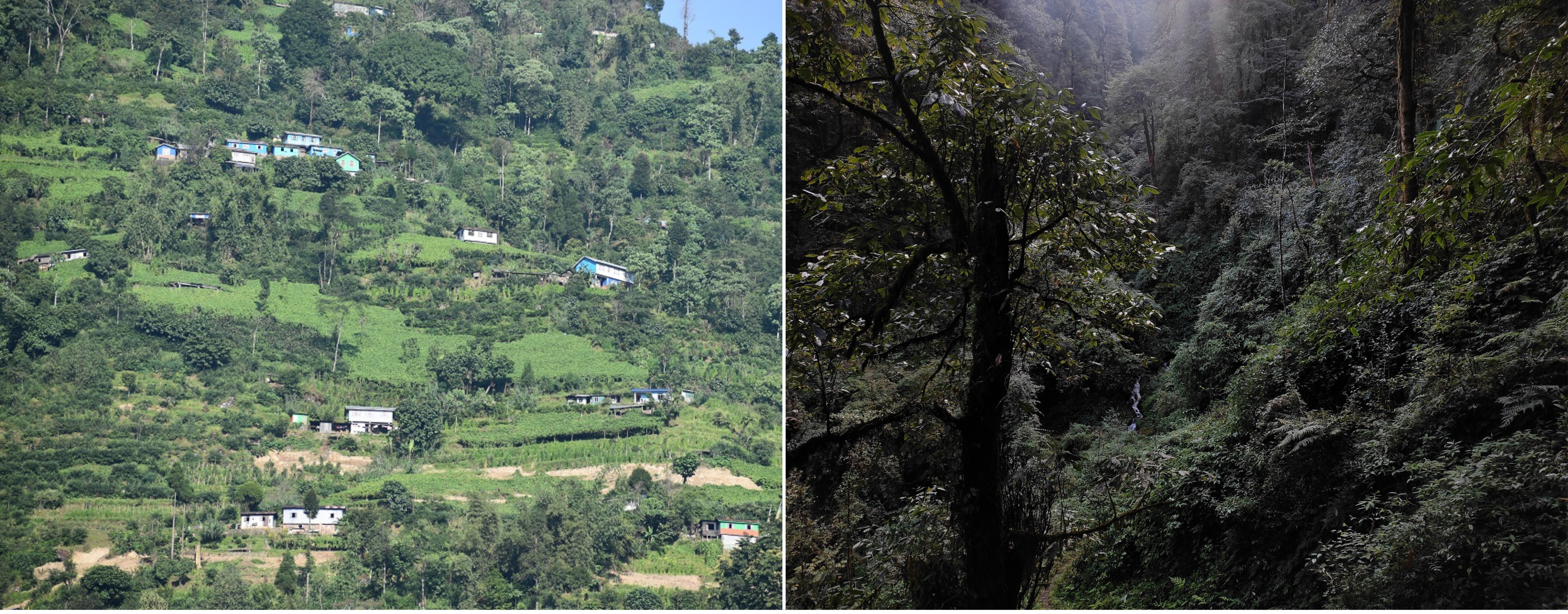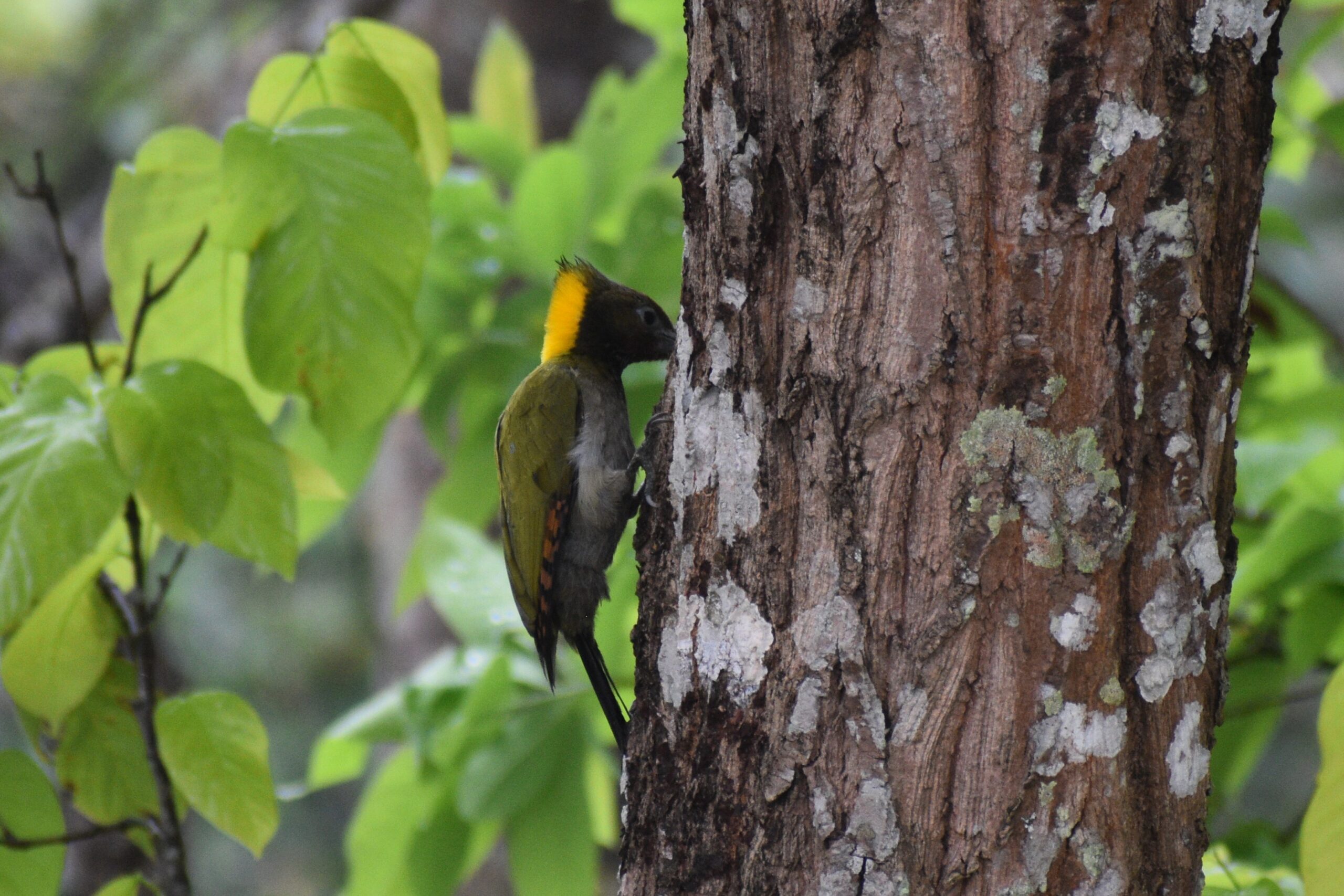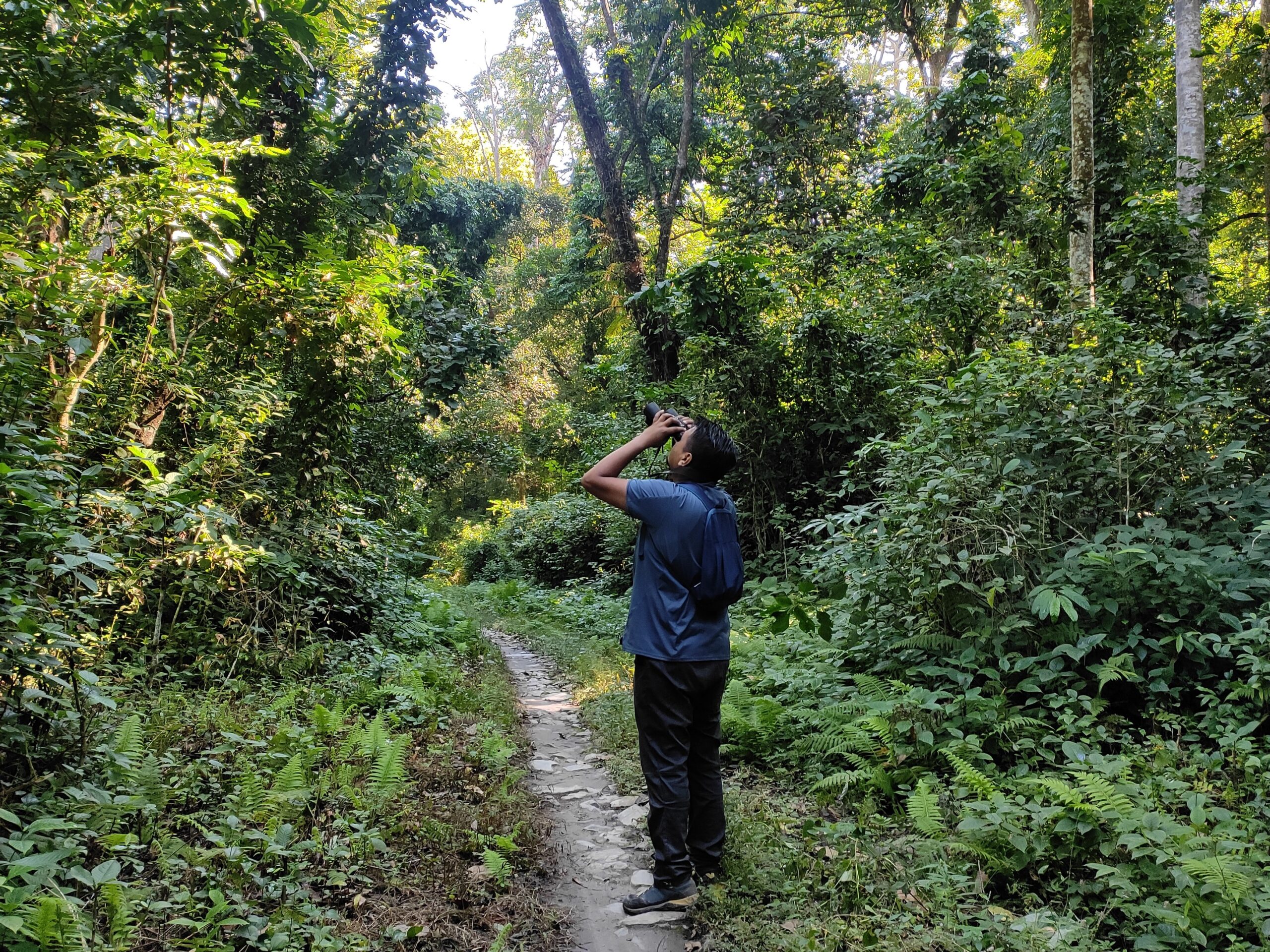I was always fascinated by hornbills (called ‘hangrayo’ in the locally spoken language Nepali) as a child. However, I live at an elevation of around 1600m, and hornbills are rarely seen in the forests around this altitude in Darjeeling. This is likely due to the extensive tea plantations and monoculture of non-fruiting trees, which have fragmented the forest landscape. Yet, stories of hornbills once frequenting my native place always intrigued me. I had also heard how people have hunted them for recreation in older days. This fascination kept growing in me and I really wanted to see hornbills in Darjeeling.
Later I joined a research project that took me to different corners of the Darjeeling-Sikkim Himalaya. It was during this project for ATREE that I finally saw this bird in its natural habitat. I was collecting data on vegetation structure in Makaibari TE, and I suddenly heard a loud flapping sound, as I turned I saw a pair of Great Hornbills. That was the biggest flying bird I had seen, and I remember telling my friends that it felt like I had seen a dinosaur.
Following this incident, I have encountered hornbills several times during fieldwork, but the memory of seeing these magnificent birds for the first time still remains one of my fondest memories of birding.
This is how my interest in birds and nature took shape..
My earliest memory of my interest in wildlife was when I was 3-4 years old and my grandfather had pasted calendar cut-outs of different wild animals on the wall of his bedroom for me. That got me interested in wildlife immediately.
Further, I live in a place called Takdah Cantonment in Darjeeling, where forests surround my house, so interest in birds and nature came naturally.
The high diversity of birds in Darjeeling Himalaya also made sure that I saw several new birds throughout the year as a child. Later during my masters, I remember, I had just bought a camera in 2015 and would photograph every bird I could see. When I first sat down to identify them, I realised I had captured 52 species of birds in just two days. This made me want to learn more about birds.
While I was doing my Masters in Darjeeling Government College, I did a review on birds of Darjeeling for an internal seminar as part of my degree, and realised that no recent work on birds had been done, and the most recent and significant work on birds of Darjeeling dated back to the 1920s. Moreover, there was no recent work on higher vertebrates in the Darjeeling Himalaya. That is when I realised the scope of conducting research on faunal diversity of Darjeeling. My sense of belongingness to the region made me passionate to work towards this goal. Later, I did my masters dissertation on the diversity of higher vertebrates in Takdah and surrounding areas of Darjeeling. My work focused on documenting the diversity of birds, herpetofauna, and mammals in the study area. I have published papers on amphibians and squamate reptiles based on this work.
Immediately after my Masters, I got an opportunity to work in a project funded by the National Mission on Himalayan Studies (NMHS) that focused on assessing key biodiversity components and ecosystem services in the socio-ecological landscapes of the Darjeeling-Sikkim Himalaya. This provided me with much-needed exposure. For the project, I was responsible for the ecosystem services component, but I also worked on trees, butterflies, birds, and citizen science, and organised many village-level workshops and trainings involving the local communities of Darjeeling-Sikkim Himalaya. During this time, I got to meet and work with many eminent personalities in the field of ornithology and conservation biology from the landscape (Sarala Khaling, Sunita Pradhan, Bhoj Kumar Acharya and Basundhara Chettri).
 An agroforest in Jhepi (Left) and an oak-dominated reserve forest in Darjeeling (Right)
An agroforest in Jhepi (Left) and an oak-dominated reserve forest in Darjeeling (Right)
I am currently working as a Research Associate at ATREE, and pursuing my PhD from the University of Calcutta under the supervision of Prof. Goutam Kumar Saha and Dr. Sarala Khaling. For my PhD, I am working on the woodpecker communities in the differently-managed forests of Darjeeling, Eastern Himalaya. The study focuses on understanding how woodpecker communities respond to different forest management regimes outside protected areas, and what their presence indicates in the landscape.
 A Greater Yellownape
A Greater Yellownape
Apart from research, I also work towards creating awareness about biodiversity among the local communities. For the past few years, with the help of my project team members, I have been conducting capacity building workshops in different parts of Darjeeling targeting local community members aspiring to be nature guides (short reports can be found in ATREE’s quarterly newsletter, Eastern Himalaya). This work is being supported by the Oriental Bird Club (report here) and the Rufford Foundation (report here) through small conservation grants.
 Birding guides from the local community trained in a birding guide training workshop (Left), Participants of a birding guide training during field session (Right)
Birding guides from the local community trained in a birding guide training workshop (Left), Participants of a birding guide training during field session (Right)
I love what I do because…
I love fieldwork. It allows me to be closer to nature and to meet genuine people from the landscape. Apart from monsoon months when it is difficult to conduct fieldwork in my study area, other seasons are great to be in the field. Also, there is always something new to learn in the field.
 Me observing birds in a reserve forest in Darjeeling.
Me observing birds in a reserve forest in Darjeeling.
Challenges I have faced..
As everyone would agree, acquiring funds to conduct fieldwork is a challenge, especially when without a fellowship. However, I was lucky to have very supportive supervisors during this phase of my work. Secondly, travelling during monsoon months and conducting field work is a challenge in the Himalaya. I have had to extend my stays in the field, reschedule sampling dates, and walk long distances due to landslides and road blockages caused by heavy rainfall and flash floods.
My advice to young researchers is..
Keep your eyes open in the field as you never know what you may stumble upon. Learning to be in the field and to acquire skills to become a good birder is always a plus when you want to pursue a career in ornithology. Being passionate about birds is important but it should come naturally. Most importantly, being disciplined is a must, because sampling birds in the early mornings during a long ecological study can be very exhausting, while sampling across seasons is challenging due to extreme weather conditions and varying vegetation especially in the highly seasonal forests.
Aditya Pradhan
[email protected]
PhD Scholar at the Department of Zoology, University of Calcutta
Institutional affiliation: Ashoka Trust for Research in Ecology and the Environment (ATREE)
Instagram handle
ResearchGate profile

